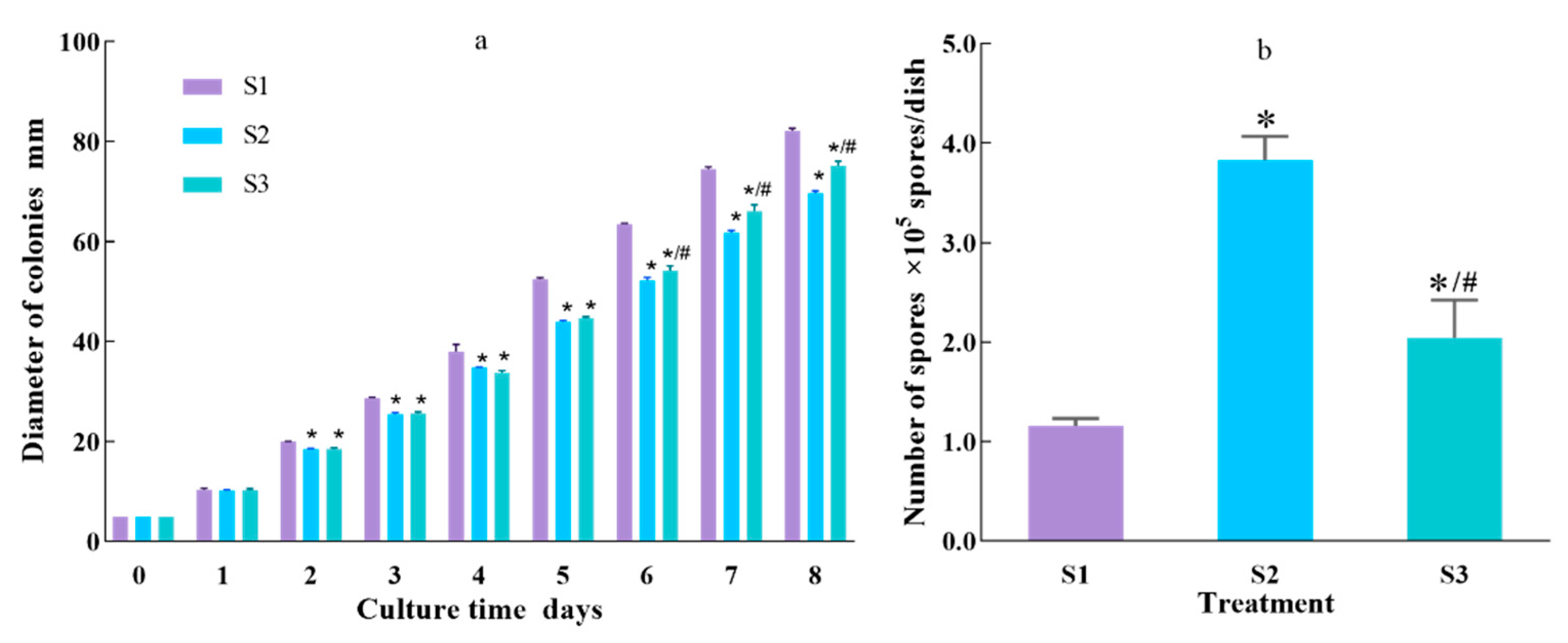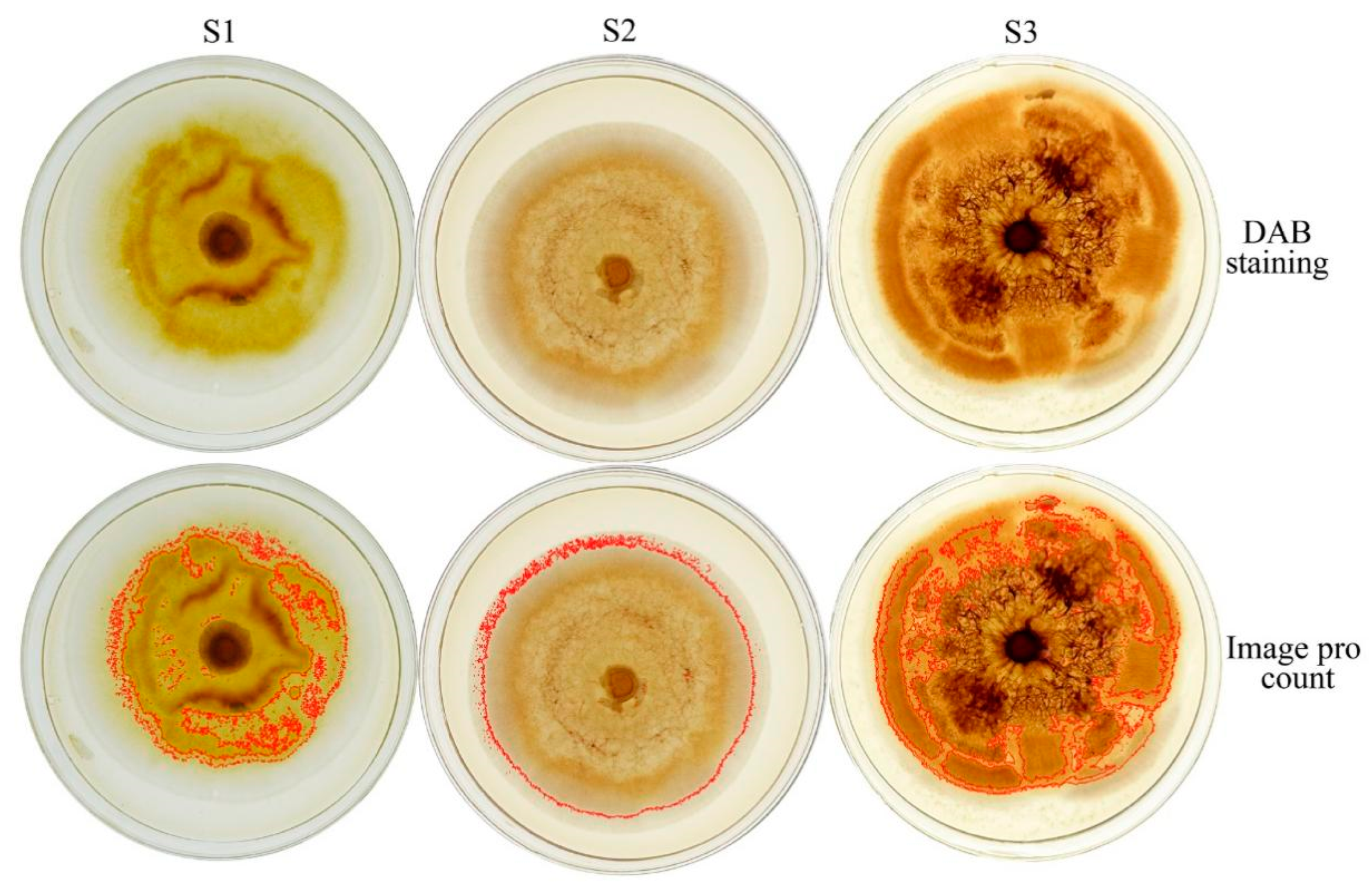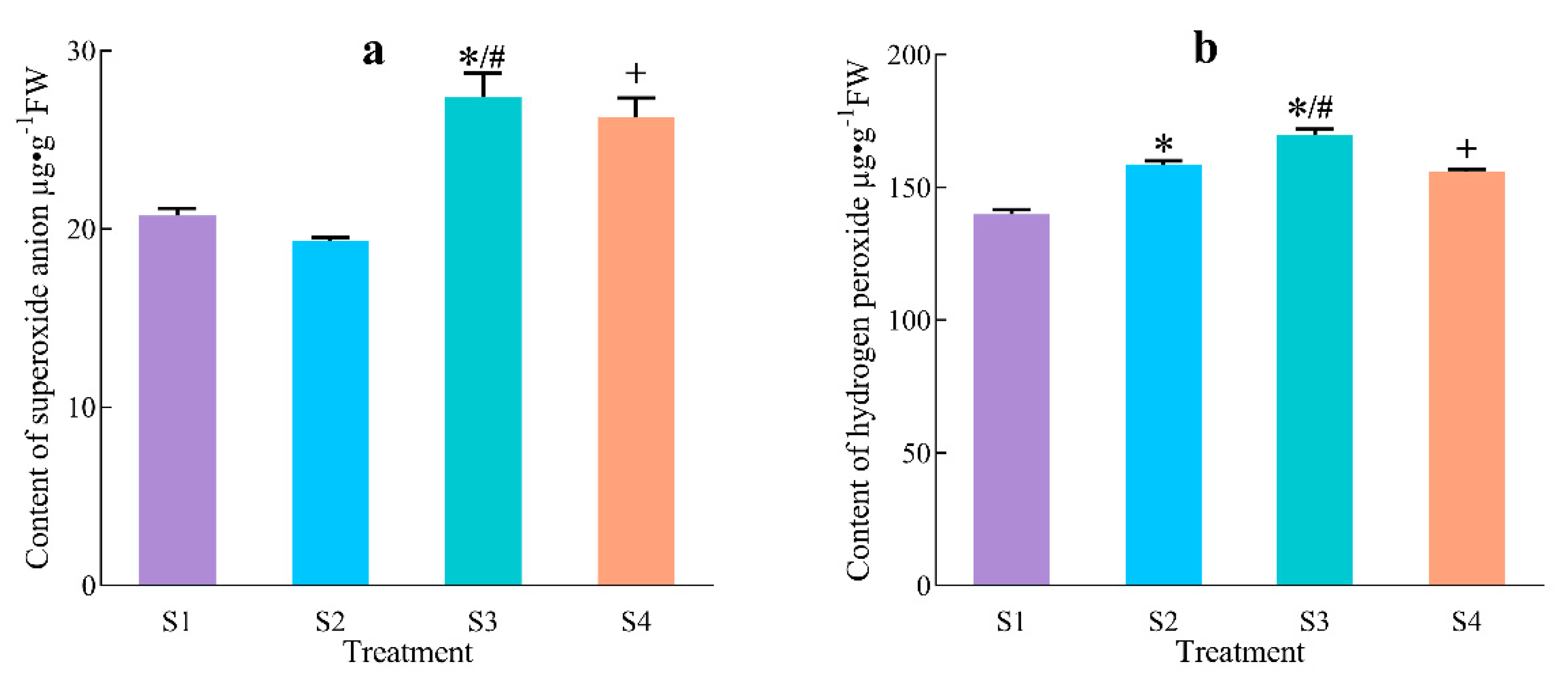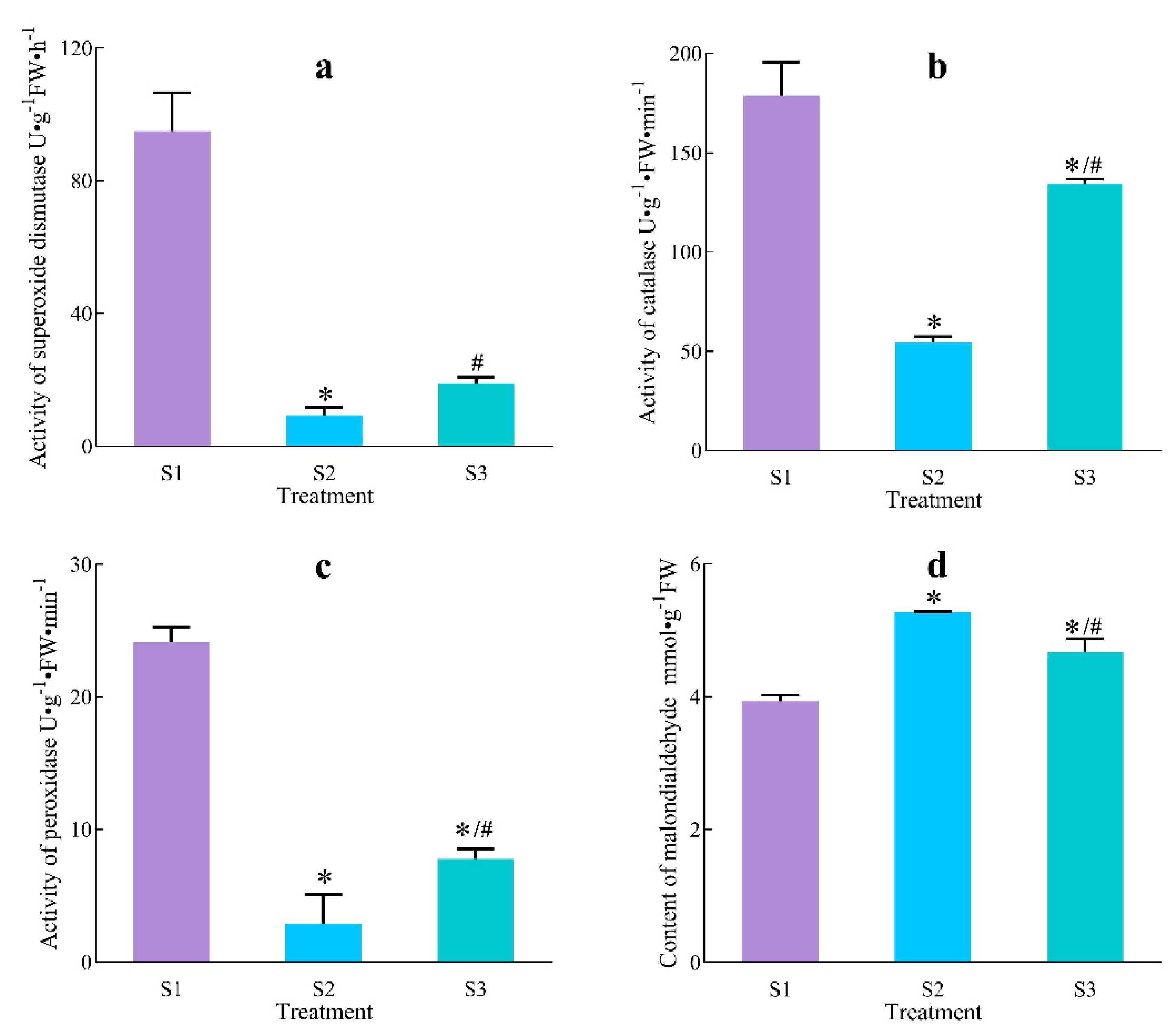ROS Regulate NCF2, Key Metabolic Enzymes and MDA Levels to Affect the Growth of Fusarium solani
Abstract
:1. Introduction
2. Materials and Methods
2.1. Fungi
2.2. Treatment and Sample Collection
2.3. Transcriptome Extraction, Sequencing, Comparison and Analysis
2.4. Real-Time Quantitative PCR Expression Analysis
2.5. Determination of MDA Content
2.6. The Superoxide Anion(O2−) and Hydrogen Peroxide (H2O2) Content Assay
2.7. Enzyme Extraction
2.8. Enzymatic Activity Assays
2.9. Histochemical Detection of ROS
2.10. Statistical Analysis
3. Results
3.1. Colony Growth and Spore Number
3.2. Colony Histochemical Detection of ROS
3.3. mRNA Expression of NCF2, SOD1, CTA1 and PXMP4
3.4. Colony ROS Level
3.5. Colony Oxidant–Antioxidant Level
4. Discussion
5. Conclusions
Author Contributions
Funding
Institutional Review Board Statement
Informed Consent Statement
Data Availability Statement
Acknowledgments
Conflicts of Interest
Abbreviations
References
- Li, H.; Li, G.Y.; Fu, J.H. Identification of the causing agent of wolfberry root rot in Xinjiang. J. Plant Protect. 1998, 25, 253–257. [Google Scholar]
- Lu, Z.K.; Yang, J.N. Occurrence and control of wolfberry root rot. J. Plant Protect. 1994, 21, 249–254. [Google Scholar]
- Li, J.; Feng, L.D.; Wang, Y.K.; He, J.; Chen, X.R. Identification and biological characteristics of dominant pathogens of Lycium bararum root rot in Gansu Province. Arid Zone Res. 2017, 34, 1093–1100. [Google Scholar]
- Poljak, B.; Jamnik, P.; Raspor, P.; Miklós, P. Oxidation-Antioxidation-Reduction Processes in the Cell: Impacts of Environmental Pollution, 2nd ed.; Elsevier: Amsterdam, The Netherlands, 2019; pp. 831–837. [Google Scholar]
- Taheri, P.; Irannejad, A.; Goldani, M.; Tarighi, S. Oxidative burst and enzymatic antioxidant systems in rice plants during interaction with Alternaria alternata. Eur. J. Plant Pathol. 2014, 140, 829–839. [Google Scholar] [CrossRef]
- Segmüller, N.; Kokkelink, L.; Giesbert, S.; Kan, J.V.; Tudzynski, P. NADPH oxidases are involved in differentiation and pathogenicity in Botrytis cinerea. Mol. Plant-Microbe Interact. 2008, 21, 808–819. [Google Scholar] [CrossRef] [PubMed] [Green Version]
- Magnani, F.; Nenci, S.; Fananas, E.M.; Ceccon, M.; Romero, E.; Fraaije, M.W. Crystal structures and atomic model of NADPH oxidase. Proc. Natl. Acad. Sci. USA 2017, 114, 6764–6769. [Google Scholar] [CrossRef] [Green Version]
- Babior, B.M.; Lambeth, J.D.; Nauseef, W. The Neutrophil NADPH Oxidase. Arch. Biochem. Biophys. 2002, 397, 342–344. [Google Scholar] [CrossRef]
- Rossi, D.C.P.; Gleason, J.E.; Sanchez, H.; Mcnees, C.; Schatzman, S.; Culbertson, E. 294—Candida albicans FRE8 encodes a member of the NADPH oxidase family that produces a burst of ROS during fungal morphogenesis. Free Radic. Biol. Med. 2017, 112, 194–195. [Google Scholar]
- Grissa, I.; Frédérique, B.; Grognet, P.; Grossetete, S.; Silar, P. The Nox/Ferric reductase/Ferric reductase-like families of Eumycetes. Fungal Biol. 2010, 114, 766–777. [Google Scholar] [CrossRef]
- Heller, J.; Tudzynski, P. Reactive oxygen species in phytopathogenic fungi: Signaling, development, and disease. Annu. Rev. Phytopathol. 2011, 49, 369–390. [Google Scholar] [CrossRef]
- Takemoto, D.; Scott, T.B. A p67phox-like regulator is recruited to control hyphal branching in a fungal-grass mutualistic symbiosis. Plant Cell 2006, 18, 2807–2821. [Google Scholar] [CrossRef] [PubMed] [Green Version]
- Donofrio, N.M.; Wilson, R.A. Redox and rice blast: New tools for dissecting molecular fungala-plant interactions. New Phytol. 2014, 201, 367–369. [Google Scholar] [CrossRef] [PubMed]
- Schuermann, J.; Buttermann, D.; Herrmann, A.; Giesbert, S.; Tudzynski, P. Molecular characterization of the NADPH oxidase complex in the ergot fungus Claviceps purpurea: CpNox2 and CpPls1 are important for a balanced host-pathogen interaction. Mol. Plant-Microbe Interact. 2013, 26, 1151–1164. [Google Scholar] [CrossRef] [Green Version]
- Cudejkova, M.M.; Vojta, P.; Josef, V.; Galuszka, P. Quantitative and qualitative transcriptome analysis of four industrial strains of Claviceps purpurea with respect to ergot alkaloid production. New Biotechnol. 2016, 33, 743–754. [Google Scholar] [CrossRef] [PubMed]
- Roca, M.G.; Weichert, M.; Siegmund, U.; Tudzynski, P.; Fleissner, A. Germling fusion via conidial anastomosis tubes in the grey mould Botrytis cinerea requires NADPH oxidase activity. Fungal Biol. 2012, 116, 380–387. [Google Scholar] [CrossRef]
- Kim, H.J.; Chen, C.; Kabbage, M.; Dickman, M.B. Identification and characterization of Sclerotinia sclerotiorum NADPH Oxidases. Appl. Environ. Microb. 2011, 77, 7721–7729. [Google Scholar] [CrossRef] [Green Version]
- Brun, S.; Malagnac, F.; Bidard, F.; Lalucque, H.; Silar, P. Functions and regulation of the Nox family in the filamentous fungus Podospora anserina: A new role in cellulose degradation. Mol. Microbiol. 2010, 74, 480–496. [Google Scholar] [CrossRef]
- Egan, M.J.; Wang, Z.Y.; Jones, M.A.; Smirnoff, N.; Talbot, N.J. Generation of reactive oxygen species by fungal NADPH oxidases is required for rice blast disease. Proc. Natl. Acad. Sci. USA 2008, 104, 11772–11777. [Google Scholar] [CrossRef] [Green Version]
- Marschall, R.; Schumacher, J.; Siegmund, U.; Tudzynski, P. Chasing stress signals-exposure to extracellular stimuli differentially affects the redox state of cell compartments in the wild type and signaling mutants of Botrytis cinerea. Fungal Genet. Biol. 2016, 90, 12–22. [Google Scholar] [CrossRef]
- Nallely, C.D.; Karen, A.D.; Hansberg, W.; Jesús, A. NADPH oxidases NOX-1 and NOX-2 require the regulatory subunit NOR-1 to control cell differentiation and growth in Neurospora crassa. Eukaryot. Cell. 2008, 7, 1352–1361. [Google Scholar]
- Leslie, J.; Summerell, B. The Fusarium Laboratory Manual; Blackwell Publishing: Ames, IA, USA, 2016; pp. 28–29. [Google Scholar]
- Thakur, A.; Singh, V.; Kaur, A.; Kaur, S. Suppression of Cellular Immune Response in Spodoptera litura (Lepidoptera: Noctuidae) Larvae by Endophytic Fungi Nigrospora oryzae and Cladosporium uredinicola. Ann. Entomol. Soc. Am. 2014, 107, 674–679. [Google Scholar] [CrossRef]
- Yang, I.S.; Kim, S. Analysis of Whole Transcriptome Sequencing Data: Workflow and Software. Genom. Inform. 2015, 13, 119–125. [Google Scholar] [CrossRef] [PubMed]
- Livak, K.J.; Schmittgen, T.D. Analysis of relative gene expression data using real-time quantitative PCR. Methods 2002, 25, 402–408. [Google Scholar] [CrossRef] [PubMed]
- Tao, Y.; Van, P.A.F.; Huang, Q.; Shao, Y.; Zhang, L.; Xie, B. Identification of novel and robust internal control genes from Volvariella volvacea that are suitable for RT-qPCR in filamentous fungi. Sci. Rep. 2016, 6, 29236. [Google Scholar] [CrossRef] [Green Version]
- Hodges, D.M.; Delong, J.M.; Forney, C.F. Improving the thiobarbituric acid-reactive-substance assay for estimating lipid peroxidation in plant tissues containing anthocyanin and other interfering compounds. Planta 1999, 207, 604–611. [Google Scholar] [CrossRef]
- Wang, A.G.; Luo, G.H. Quantitative relation between the reaction of hydroxylamine and superoxide anion radicals in plants. Plant Physiol. Commun. 1990, 84, 2895–2898. [Google Scholar]
- Prochazkova, D.; Sairam, R.K.; Srivastava, G.C.; Singh, D.V. Oxidative stress and antioxidant activity as the basis of senescence in maize leaves. Plant Sci. 2001, 161, 765–771. [Google Scholar] [CrossRef]
- Rao, M.V.; Paliyath, G.; Ormrod, D.P. Ultraviolet-B- and ozone-induced biochemical changes in antioxidant enzymes of Arabidopsis thaliana. Plant Physiol. 2001, 110, 125e36. [Google Scholar] [CrossRef] [Green Version]
- Wang, Y.S.; Tian, S.P.; Xu, Y. Effects of high oxygen concentration on pro- and anti-oxidant enzymes in peach fruits during postharvest periods. Food Chem. 2005, 91, 99–104. [Google Scholar] [CrossRef]
- Venisse, J.S.; Gullner, G.; Brisset, M.N. Evidence for the involvement of an oxidative stress in the initiation of infection of pear by Erwinia amylovora. Plant Physiol. 2001, 125, 2164–2172. [Google Scholar] [CrossRef] [Green Version]
- Barceló, A.R. Hydrogen peroxide production is a general property of the lignifying xylem from vascular plants. Ann. Bot. 1998, 82, 97–103. [Google Scholar] [CrossRef] [Green Version]
- Shinogi, T.; Suzuki, T.; Kurihara, T.; Narusaka, Y.; Park, P. Microscopic detection of reactive oxygen species generation in the compatible and incompatible interactions of Alternaria alternata Japanese pear pathotype and host plants. J. Gen. Plant Pathol. 2003, 69, 7–16. [Google Scholar] [CrossRef]
- Lambeth, J.D.; Neish, A.S. Nox enzymes and new thinking on reactive oxygen: A double-edged sword revisited. Annu. Rev. Pathol. 2014, 9, 119–145. [Google Scholar] [CrossRef] [PubMed]
- Mittler, R.; Vanderauwera, S.; Gollery, M.; Van, B.F. Reactive oxygen gene network of plants. Trends Plant Sci. 2004, 9, 490–498. [Google Scholar] [CrossRef]
- Foyer, C.H.; Noctor, G. Redox Signaling in Plants. Antioxid. Redox Sign. 2013, 18, 2087–2090. [Google Scholar] [CrossRef] [PubMed]
- Mittler, R.; Vanderauwera, S.; Suzuki, N.; Miller, G.; Tognetti, V.B.; Vandepoele, K. ROS signaling: The new wave? Trends Plant Sci. 2011, 16, 300–309. [Google Scholar] [CrossRef]
- Ekanayake, G.; LaMontagne, E.D.; Heese, A. Never walk alone: Clathrin-coated vesicle components in plant immunity. Annu. Rev. Phytopathol. 2019, 57, 387–409. [Google Scholar] [CrossRef]
- Diaz, J.M.; Plummer, S.; Hansel, C.M.; Andeer, P.F.; Saito, M.A.; McIlvin, M.R. NADPH-dependent extracellular superoxide production is vital to photophysiology in the marine diatom Thalassiosira oceanica. Proc. Natl. Acad. Sci. USA 2019, 116, 201821233. [Google Scholar] [CrossRef] [Green Version]
- Malagnac, F.; Lalucque, H.; Lepère, G.; Silar, P. Two NADPH oxidase isoforms are required for sexual reproduction and ascospore germination in the filamentous fungus Podospora anserina. Fungal Genet. Biol. 2004, 41, 982–997. [Google Scholar] [CrossRef]
- Li, W.; Christopher, M.; Sean, W.; Joshi, M.; Subramaniam, R. Characterization of NADPH oxidase genes NoxA and NoxB in Fusarium graminearum. Can. J. Plant Pathol. 2014, 36, 12–21. [Google Scholar]
- Libik-Konieczny, M.; Kozieradzka-Kiszkurno, M.; Desel, C.; Michalec-Warzecha, Ż.; Miszalski, Z.; Konieczny, R. The localization of NADPH oxidase and reactive oxygen species in in vitro-cultured Mesembryanthemum crystallinum L. hypocotyls discloses their differing roles in rhizogenesis. Protoplasma 2015, 252, 477–487. [Google Scholar] [CrossRef] [PubMed] [Green Version]
- Passaia, G.; Margis-Pinheiro, M. Glutathione peroxidases as redox sensor proteins in plant cells. Plant Sci. 2015, 234, 22–26. [Google Scholar] [CrossRef]
- Mittler, R. ROS Are Good. Trends Plant Sci. 2016, 22, 11–19. [Google Scholar] [CrossRef] [PubMed] [Green Version]
- Vanderauwera, S.; Suzuki, N.; Miller, G.; van de Cotte, B.; Morsa, S.; Ravanat, J.-L.; Hegie, A.; Triantaphylidès, C.; Shulaev, V.; van Montagu, M.C.E.; et al. Extranuclear protection of chromosomal DNA from oxidative stress. Proc. Natl. Acad. Sci. USA 2011, 108, 1711–1716. [Google Scholar] [CrossRef] [Green Version]
- Ben, R.K.; Benzarti, M.; Debez, A.; Bailly, C.; Savouré, A.; Abdelly, C. NADPH oxidase-dependent H2O2 production is required for salt-induced antioxidant defense in Arabidopsis thaliana. J. Plant Physiol. 2015, 174, 5–15. [Google Scholar]
- Bao, G.H.; Bi, Y.; Li, Y.C.; Kou, Z.; Hu, L.; Ge, Y. Overproduction of reactive oxygen species involved in the pathogenicity of Fusarium in potato tubers. Physiol. Mol. Plant Pathol. 2014, 86, 35–42. [Google Scholar] [CrossRef]
- O’Donnell, B.V.; Tew, D.G.; Jones, O.T.; England, P.J. Studies on the inhibitory mechanism of iodonium compounds with special reference to neutrophil NADPH oxidase. Biochem. J. 1993, 290, 41–49. [Google Scholar] [CrossRef]







| GeneID | Genename | Forward Primer Sequence | Reverse Primer Sequence |
|---|---|---|---|
| NECHADRAFT_57795 | CTA1 | AGCCAGACTACCATGTCAAAG | GGAGCCTTCTTGATCTCTTCAG |
| NECHADRAFT_74783 | PXMP4 | CGATTCGCCGTCATCTACAA | CCAAAGACAAAGTAGCCTCCA |
| NECHADRAFT_81761 | NCF2 | GGCTACACTGTCTTCTCCATTC | GTAGTCCTTGGTCTTGAGGTTTC |
| NECHADRAFT_59203 | SOD1 | CCCTCTTCAAGACTTGCTTCT | GAGGATTGGGTATCTGGTTTGT |
Publisher’s Note: MDPI stays neutral with regard to jurisdictional claims in published maps and institutional affiliations. |
© 2022 by the authors. Licensee MDPI, Basel, Switzerland. This article is an open access article distributed under the terms and conditions of the Creative Commons Attribution (CC BY) license (https://creativecommons.org/licenses/by/4.0/).
Share and Cite
Li, J.; Feng, L.; Li, D.; Liu, X.; Pan, Y.; He, J.; Zhang, J. ROS Regulate NCF2, Key Metabolic Enzymes and MDA Levels to Affect the Growth of Fusarium solani. Agriculture 2022, 12, 1840. https://doi.org/10.3390/agriculture12111840
Li J, Feng L, Li D, Liu X, Pan Y, He J, Zhang J. ROS Regulate NCF2, Key Metabolic Enzymes and MDA Levels to Affect the Growth of Fusarium solani. Agriculture. 2022; 12(11):1840. https://doi.org/10.3390/agriculture12111840
Chicago/Turabian StyleLi, Jie, Lidan Feng, Dong Li, Xianglin Liu, Yangyang Pan, Jing He, and Junxia Zhang. 2022. "ROS Regulate NCF2, Key Metabolic Enzymes and MDA Levels to Affect the Growth of Fusarium solani" Agriculture 12, no. 11: 1840. https://doi.org/10.3390/agriculture12111840
APA StyleLi, J., Feng, L., Li, D., Liu, X., Pan, Y., He, J., & Zhang, J. (2022). ROS Regulate NCF2, Key Metabolic Enzymes and MDA Levels to Affect the Growth of Fusarium solani. Agriculture, 12(11), 1840. https://doi.org/10.3390/agriculture12111840






